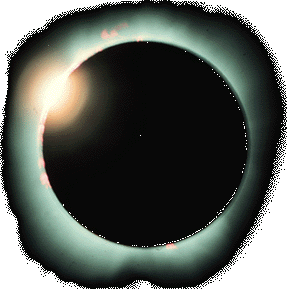|
|

For a few minutes during a total solar
eclipse, when the disk of the moon slides precisely
between our planet and the sun, we'll see something
rarely visible: the sun's hot, churning atmosphere,
called the corona. Unless light from the sun is
blocked, the corona is usually too dim for us to
see from earth. During an eclipse, we'll have a
better view of the lower corona than even space
telescopes can provide.
To routinely view the sun's corona, solar
observatories in space, such as SOHO (Solar
Heliospheric Observatory), use a kind of artificial
eclipse. The "eclipse" is made by using a solid
disk mounted in the observatory's detector. The
disk blocks light from the sun's surface, just as
the moon blocks our view of the sun during a solar
eclipse. But the detectors on space observatories
can't view the part of the sun's atmosphere just
above the surface, the layer where violent solar
storms gather their energy. Held back by the sun's
powerful magnetic fields, these storms brew until
they burst through in an exploding mass of charged
gas that can rush toward the earth at speeds up to
1250 miles a second.
These violent solar explosions are called
Coronal Mass Ejections, or CMEs. When CMEs are
pointed toward the earth, turbulent shock waves of
charged gas and their accompanying magnetic fields
can interfere with radio, television, and telephone
signals, damage satellites and disrupt satellite
communications, and build up voltages in electric
power lines. High-energy particles from these
storms also contribute to the beautiful polar light
shows known as aurora borealis (in the northern
hemisphere) and aurora australis (in the southern
hemisphere). The most violent solar storms can
threaten the safety of space-walking astronauts and
cause huge geomagnetic storms on the earth. A
direct hit by a CME in 1989 knocked out power to
Quebec and produced a lot of damage to satellites
orbiting the earth.
|

